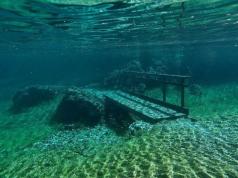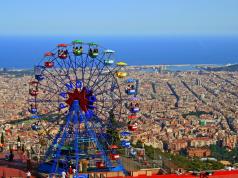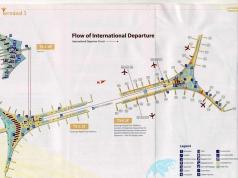The majestic Grand Palace of Fine Arts (Le Grand Palais) adorned Winston Churchill Avenue at the very end of the 19th century. Construction of a large exhibition center in the Beaux-Arts style began in 1897 and was completed in the spring of 1900 in time for the opening of the World's Fair.
Thoughts about beauty and their implementation
The start of construction of the Grand Palais was preceded by a competition of architectural designs, which did not determine a single winner. According to the decision of the competition commission, the ideas of the architects Henri Deglan, Albert Louvet, Albert Thomas were recognized as the most interesting, and the overall coordination of the work was entrusted to Charles Giraud.
The building of the Grand Palace with a facade 240 m long was erected on part of the territory that was previously occupied by the Palace of Industry, which did not meet the requirements of the time. It represents the culmination of the development of the eclectic Beaux-Arts style. Elements of classicism architecture are harmoniously combined with designs of the Art Nouveau era. The Grand Palais of Paris belongs to those examples of architecture at the turn of the century when the engineer acquired equal rights with the architect in shaping the aesthetic appearance of the building.
The impressive building with an area of 77 thousand m2 is located along the “republican axis” running from east to west. The large nave of the palace and the transverse paddock were designed by A. Deglan. He is also the author of the colonnades along the facades, the model for which was the work of V. Lalu during the reconstruction of the Louvre.
The central part of the building, designed by A. Louvet, is covered by a magnificent dome. The weight of its metal structure and glass panels is 9 thousand tons, and the highest point of the vault is located at a height of 45 m. The western wing or Palais d’Antin was built by the architect A. Thoma. The use of a huge amount of glass in the construction of the Grand Palace allows us to call it the heir to the aesthetics of D. Paxton, who built the Crystal Palace in London in 1851.
Art of decor
Monumental copper sculptural compositions by Georges Rechipon are symmetrically installed on the sides of the palace portal at a height of about 40 m. Closer to the Champs-Elysees is the sculptural group “Immortality Conquering Time”, and on the side of the Seine the first composition is “Harmony Triumphant Over Discordia”. The façade of the palace is also decorated with numerous bronze statues by sculptors Alexandre Falguier and Victor Peter.
Many halls of the Grand Palace are decorated with mosaic designs. The floor of the Elliptical Hall is paved with sandstone tiles in brown, beige and greenish colors. Its pattern repeats the cardboards proposed for interior decoration by the artist Louis Guist. 
Ten mosaic panels are located at a high height under the peristyle of A. Deglan. Their total area is 273 m2, and the total length of the work of art is 74 m. The subject of the mosaic paintings by Auguste and Rene Martin, created according to sketches by Louis Fournier, was the history of great civilizations. Each episode is dedicated to the art of a specific region: ancient Greece, Mesopotamia, Ancient Egypt, the French Middle Ages, the Italian Renaissance, India, Southeast Asia, Africa, China, Japan and the Americas.
Unity in diversity
Upon completion of construction, the Grand Palais, as expected, became one of the leading cultural and exhibition centers in Paris. But if its western wing, the Antin Palace, has been permanently occupied by the exhibition of the Museum of Discoveries and Inventions since 1937, then the eastern part of the palace was used in a very diverse way.
Along with the organization of permanent temporary art exhibitions, in a number of halls there were, over the years, architectural workshops, a customs office, a police station, a Center for Germanic and Slavic Studies, a regional center for cultural affairs, a Photographic Heritage Mission, and the National Gallery. 
The creation of a unified center for culture and art in 2007 made it possible to introduce greater rationality in the use of the palace. Now it houses the National Gallery du Grand Palais, the Palace of Discovery, and the rehearsal rooms of the Comedie Française theater. The upcoming large-scale renovation of the Grand Palais between 2020 and 2023 will transform the building with more than a century of history and prepare it to host fencing and taekwondo competitions during the 2024 Paris Olympics.
The Grand Palace in France (Grand Palais) is an absolutely stunning imaginative, majestic architectural creation, made in the Beaux Arts style. The Grand Palace is comfortably located near the Champs Elysees. It was built in 1897 in Paris, specifically for the World Exhibition, which took place in France in 1900 from April to November. And since then the Grand Palace has been known and [...]
Grand Palace in France ( Grand Palais) is an absolutely stunning imaginative, majestic architectural creation, made in the Beaux Arts style. The Grand Palace is comfortably located near Champs Elysees.
It was built in 1897, in Paris, specifically for the World's Fair, which took place in France in 1900 from April to November. And since then Grand Palace known and revered as the largest exhibition and cultural center of the French state.
An interesting fact is that the world-famous Eiffel Tower was also built for the World Exhibition, which was held in 1889. Above the two entrances of the Grand Palace are copper quadrigas made by the magnificent Georges Resipon. On the side of the Seine there is a statue “L'Harmonie triomphant de la Discorde”, which means “Harmony triumphs over discord”, and on the side of the Champs Elysees there is a statue “L’Immortalité devançant le Temps”, translated from French this expression means “Immortality precedes time itself." The western wing of the Grand Palace is occupied by the “Museum of Inventions and Discoveries”, and the northern wing houses the Art Gallery.
In the building Grand Palace The most interesting exhibitions and events are held. So, from the end of 2010 to January 2011 there was an art exhibition here Claude Monet. By the way, to be able to get into this magnificent exhibition, you had to stand in a two-hour queue.
Grand Palace (French: Grand Palais)
1 Avenue General Eisenhower, 75008 Paris, France
grandpalais.frTake the metro to Champs-Élysées – Clemenceau station
How do I save on hotels?
It’s very simple - look not only on booking. I prefer the search engine RoomGuru. He searches for discounts simultaneously on Booking and on 70 other booking sites.
The Grand Palais of Paris was built for the 1900 Universal Exhibition. The building immediately became famous for its huge glass roof. Now this building houses a science museum. In 1900, Paris solemnly hosted the World Exhibition. Due to the high importance of the event, the city planned large construction projects, including the construction of the Alexander III Bridge, the Grand Palace and the similar Small Palace.
Thanks to its domed glass roof, the Grand Palais is one of the most recognizable landmarks in Paris. Three different architects worked on the project, but the key role was played by the famous Frenchman Charles Giraud, who received carte blanche to create the Petit Palace. The building is a magnificent combination of a classic stone facade, glass and iron in the Art Nouveau style. 
The Grand Palais of Paris is to this day the largest building made of glass and iron. Its closest competitor was London's Crystal Palace, which was destroyed by a terrible fire. The Grand Palace in the Belle Epoque style has a steel frame weighing 9,400 tons, 15,000 square meters of glass, and a zinc galvanized iron roof covering an area of about 5,000 square meters. The stone interior is decorated with magnificent colorful mosaics and intricate sculptures. 
When one of the cells of the glass ceiling of the Grand Palais collapsed in 1993, the building was closed for a ten-year reconstruction. The first phase of renovations was completed in 2004, and the remainder opened in 2007. The renovations included metal frame repairs, glass replacement, and roof restoration. Some of the art masterpieces have also been updated, including Georges Recipon's horse sculptures that crown the corners of the palace. The mosaics have also been completely restored and restored. 
For a century, the Grand Palais was a public exhibition hall and the venue for many important events. And although the main gallery is now entirely dedicated to contemporary art, the palace hosts many interesting exhibitions - from displays of vintage cars to fashion shows from leading Parisian designers. 



The Grand Palais is divided into three different areas, each with its own entrance: the Museum of Science and Technology is on Franklin Roosevelt Avenue, the National Gallery of the Grand Palais (the main exhibition hall) is accessible from the Place Clemenceau, and the entrance to the Nave of the Grand Palais is open from the avenue Winston Churchill is directly opposite the Small Palace.
The Grand Palace in Paris enjoys unprecedented popularity - a majestic architectural structure has stood on this site since 1892. Most often, the building is used as an exhibition hall, telling visitors about the rich culture of France.
Paris Grand and Petit Palaces what's in them
The Grand Palace in Paris is not only a cultural monument that can tell about the architecture of those difficult times. Now its premises are occupied by two interesting museums, telling about the capital and the country in all its colors.
On one side of the building there is the Museum of Inventions and Innovative Findings, and on the other there is an art gallery. Both there and there constantly host original exhibitions on various topics.
The south of the premises will appeal to our compatriots: the Russian-language department of the Sorbonne with its own history of formation is located there. The university also happily welcomes tourists, so the Grand Palais is always full of people.
What is the Grand Palace in Paris
The Grand Palais in Paris owes its appearance to the World Exhibition held in 1990, dedicated to the great meeting of the new twentieth century, full of possible discoveries and innovative solutions.
Expert opinion
Knyazeva Victoria
Guide to Paris and France
Ask a question to an expertA huge number of architects fought for the right to build it, but only three, recognized as the best of the best, won. The future building was divided into zones, entrusting each of the architects with a part. Thanks to this decision, the project turned out to be harmonious, but at the same time original and interesting.
Since then, practically nothing has changed - the Grand Palais is considered the largest exhibition hall in the world.
Exhibitions at the Grand Palais in Paris

Here you can see a huge number of interesting presentations related to history, science and the arts, as well as fashion, cars and even animals. It is the Grand Palais in Paris that hosts Chanel's annual fashion show.
Picasso Museum
Grand Palace opening hours
To visit the palaces of Paris at the right time, you need to know when they are open. No tourist wants to stand in front of a closed door or get caught in rush hour, especially if his time is limited.
You can visit the attraction from Wednesday to Friday, between 9 am and 10 pm. But please note: The Grand and Petit Palais in Paris operate only in local time.
Sometimes this schedule changes. This usually happens during special exhibitions. In this case, the opening hours should be checked individually with the organizer.
Grand Palais in Paris official website
To find out how the palaces of Paris work and understand what exhibitions are being held there in the near future, just visit the official website of the building (www.grandpalais.fr).
It talks about how to find a building without traveling all over Paris, what is planned in the near future and how much it costs to visit a particular exhibition.
Petit Palais Museum of Paris

The Grand and Petit Palais in Paris were built almost simultaneously, so the small brother of the main building also has its own rich history. It’s worth a visit just for the beautiful design - the façade of the building looks original and unusual.
Catacombs of Paris
Like other buildings, the Petit Palais is also rich in interesting exhibitions. The entire history of art can be found here.
Petit Palais in Paris exposition
 Now there are no permanent exhibitions there, like in the big one, but in the petit palais there is still something to see. It is rich in fashion and paintings painted by great painters at different times.
Now there are no permanent exhibitions there, like in the big one, but in the petit palais there is still something to see. It is rich in fashion and paintings painted by great painters at different times.
The Grand Palais (Grand Palace) on the Champs Elysees is a luxurious building in the Beaux Arts style, a major cultural and exhibition center.
It was built for the 1900 World Exhibition. At first they doubted whether it would be possible to eclipse the success of the Eiffel Tower at the last exhibition? We decided that this time the emphasis would be on art. The Grand Palace of Fine Arts (full name Grand Palais) became part of a large-scale redevelopment of the western part of Paris.
Construction was difficult. The soil could not support the weight of the building, 3,400 oak piles were needed, because of this the estimate was greatly exceeded. A gigantic amount of stone, steel, crushed stone, bricks, equipment and labor was required. One and a half thousand construction workers also created problems - strikes broke out.
The result was worth it. A majestic building appeared with a steel frame, a huge glass roof, a large number of statues, friezes, and mosaics. Bronze quadrigas by Georges Recipon crown both wings of the facade - allegorical statues representing Immortality, ahead of time, and Harmony, triumphant over discord. The inscription on the pediment proclaims that the Republic dedicates this building to the glory of French art.
From the very beginning, the Palace became a venue for exhibitions – dedicated to innovation and technology and, of course, artistic ones. It was here that Matisse and Gauguin gained recognition, and it was here that Cubism, led by the still unknown Picasso, first announced itself.
During World War II, the building was requisitioned as a military hospital with a thousand beds. Artists and sculptors who were not subject to mobilization decorated the wards or made molds for prosthetics. During the occupation, the palace was used to host Nazi propaganda exhibitions, and during the liberation of Paris, it was used as the headquarters of the Resistance.
Today the Grand Palais is still an artistic center. Exhibitions, fashion parades (the Chanel fashion house holds its shows here), car shows, horse shows, book fairs, live concerts, the world fencing championship - it is difficult to list all the events taking place under the glass roof of the Grand Palais des Beaux-Arts.







